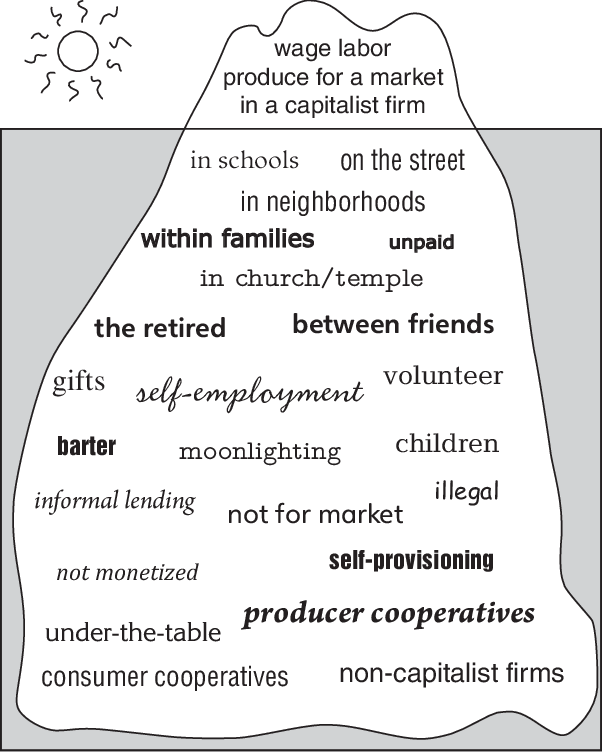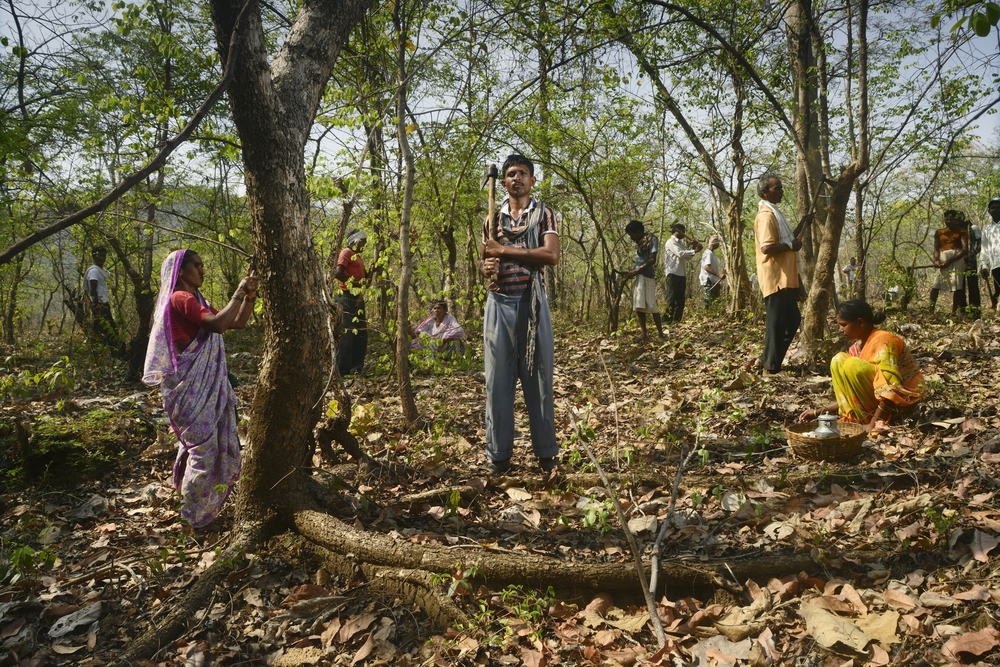Honoring Commons-based Circuits of Value
It is becoming clear that our path beyond the pandemic, climate change, social inequality and much else will require some serious social and political transformations. But to navigate a reliable path forward, we must learn how to protect forms of value that cannot be expressed through price or created through markets. Otherwise, the capitalist machine, and especially finance, will capture, colonize and control the many powerful nonmarket realms of value-creation that are vital to our survival.
We must therefore ask: How can we safeguard ecological, personal, social, local, ethical, intergenerational value in a world dominated by capitalist finance and enforced by its legal codes for property and commerce?

The late David Graeber, an anthropologist and activist who taught at the London School of Economics, pointed out that the idea of value is an important part of human meaning-making. People express a sense of value as they adopt identities, social practices, and culture. In this sense, value-creation should be the starting point for thinking about politics, Graeber said. As he noted in his 2001 book, Toward an Anthropological Theory of Value, “The ultimate stakes of politics are not even the struggle to appropriate value [as political ideologies attempt to do]; it is the struggle to establish what value is. Similarly, the ultimate freedom is not the freedom to create or accumulate value, but the freedom to decide (collectively or individually) what it is that makes life worth living. In the end, then, politics is about the meaning of life.”
Capitalist finance declines to address these questions because it regards the answers as self-evident and settled. (In addition, opening up a broader discussion of value would be terribly disruptive to some lucrative, well-established enterprises.) The investment world asserts that maximizing financial forms of value – through efficiency, productivity, extraction of natural resources, growth, etc. – “grows a bigger pie for everyone.”
Unfortunately, financial forms of value tend to siphon away value from the “real economy” of production that everyone depends upon, so finance arrogates to itself the lion’s share of benefits from the economy. Even though the pandemic wiped out at least 225 million full-time jobs worldwide, the world’s ten richest men, cosseted within a financial system, saw their wealth grow by half a trillion in 2020, writes the anti-poverty group Oxfam; their total wealth was equivalent to G20 governments’ total Covid-19 recovery spending. Given this sort of distributional power, it is entirely appropriate to have a meaningful debate about what sorts of value contemporary finance should maximize.
The idea of the commons can help us answer this question. Commons-friendly finance makes the bold claim that there are other circuits of value-creation that lie outside of the market that finance must actively nourish and protect. These other circuits – our term for committed, symbiotic relationships in a flourishing living system – are not static forms of objectified value measured by price, as finance and property law dictate. They are dynamic living systems whose actual value eludes quantification and monetization.

Inspired by feminist economic theory, J.K. Gibson-Graham uses an iceberg image to suggest how much of “the economy” lies outside of formal markets. Huge swaths of value-creating human activity – care work, parenting, social nutrition, open source software, the social economy, community gardens, etc. – remain largely invisible to economics and are treated as inconsequential. Many of these non-market activities are not necessarily coherent and persistent enough to constitute a commons – a stable nonmarket circuit of value-creation. Nonetheless, the behaviors enumerated by the illustration [Figure 1] suggest how much economic work takes place outside of wage labor and production for capitalist markets, in non-monetized forms.
These robust circuits of value-creation, often marginalized by standard economics and finance, can be seen in the generativity of local communities, ecosystems that comprise the biosphere, networks of social cooperation, and intergenerational lineages of people. However, these circuits of value-creation live in a fraught tension with markets because capitalism is structurally motivated to own and control the relational value that they create. It seeks to monetize that value, especially biophysical assets, and accumulate them as privately held capital. That is what enclosures of the commons are all about – the commodification of common wealth by converting it into private property that can be sold in markets and converted into state-backed money.
Whether by choice or age-old prejudice, conventional finance generally ignores or misconstrues relational circuits of value-creation. Marx alluded to this lacuna in economic theory with his “labor theory of value” analysis. He argued that price does not reflect the actual value of the actual inputs needed for market production because economics doesn’t really care about nonmarket inputs that are needed; they are secondary and contextual, and therefore something “others” or “nature” can take responsibility for. In other words, the fruits of relational value are “free for the taking.”
Market prices may measure the man-hours needed for labor, noted Graeber, but they don’t take account of the value of the tools, know-how, materials, culture, and social reproduction (child-rearing, education, socialization) needed to provide human labor. Feminist scholars like Silvia Federici have carefully documented how the social reproduction of labor is considered “off the books” and gendered as “women’s work,” effectively rendering child-rearing and care as “free” inputs for capitalist production. Suffice it to say that a $15/hour minimum wage does not begin to cover the actual costs of sustaining a person’s life and family with dignity; that shortfall is subsidized by individuals themselves and, in part, by government welfare programs.

Marx aside, even progressive economists often have trouble recognizing nonmarket, nonmonetized value as a vital wellspring of wealth. Economist Mariana Mazzucato, for example, regards “value” as monetized property as traded in markets, treating other forms of value as personal values that exist outside of what we call “the economy.” This premise immediately marginalizes countless realms of serious value-creation even though markets paradoxically depend on these nonmarket sources of value: the complex relations among soil, microbiota, plants, and hydrological cycles that sustain agriculture, fisheries, and wildlife; the social practices that engender trust and therefore functional markets; the varieties of human care that must be present if a workforce is to succeed; the uncompensated cooperation that generates open source software.
The value generated in these circuits is not driven by market transactions among individuals. It comes from complicated, dynamic, and subtle relationships and norms among living collectives. Living systems are generative because there is a requisite variety of interdependent species that are mutually catalytic and symbiotic. “The current revolution in ‘plant communications’ shows that even herbs, trees and mushrooms are capable of communication, choice and mutual aid,” writes biologist and ecophilosopher Andreas Weber. This procreative logic of nature, forged over millennia of evolution, is profoundly generative, yet it has been seriously damaged by the capitalist apparatus as it imposes its objectified, reductionist notions of value.
It is helpful to look more closely at some specific, alternative circuits of value-creation. There is the care economy, as described by many feminist economists, is a realm that draws upon the love, devotion and commitment of people as they provide to family, colleagues, and friends in the course of work, education, household upkeep, socialization, and eldercare. Care is valuable precisely because it relies on known and trusted people (not just anyone) who show a generous spirit and lots of time. For this very reason, authentic human care is not easily integrated with markets and their monetary incentives and productivity demands.
In a related vein, anthropologists have long studied gift economies as a source of social meaning-making, bonding, and collective provisioning. Complex circuits of gift exchange can be seen in premodern societies, academic communities, artistic networks, and online communities. Lewis Hyde explains how the circulation of gifts generates increases of value: “Capital earns profit and the sale of a commodity turns a profit, but gifts that remain gifts do not earn profit, they give increase. The distinction lies in what we might call the vector of the increase: in gift exchange, the increase stays in motion and follows the object, while in commodity exchange it stays behind as profit.”
In short, the “surplus” generated by circuits of gift-exchange must keep moving as a gift – meeting needs and weaving community in the process. Treating the surplus as profit, a necessary return on capital, objectifies the surplus as money, removes it from circulation for private control, and essentially renders it dead, as a lump of capital to be deployed to generate still more objectified value. Commercializing a gift tends to destroy the fecundity of the gift economy, as Hyde explains. Or as record producer Quincy Jones put it, “When you chase music for money, God walks out of the room.” This insight makes clear why artistic gift economies (for example) must protect the integrity of gift exchange among artists. It’s the only way to assure that their generativity can continue.
Natural ecosystems of plants, animals, microorganisms, land, and other biophysical elements constitute mutually supportive webs of generative aliveness and emergent complexity. Through the “interbeing” of their mutual cooperation (and competition), they create a natural usufruct – renewable resources upon which markets rely. The contemporary fields of complexity science, biosemiotics, and the new animism, building on the Gaia hypothesis of the 1970s, are confirming what Indigenous peoples have known for millennia: autopoiesis and symbiotic relationships in nature are profoundly fecund. Indigenous peoples have built cosmologies around this idea, that humans are entangled in a meshwork of bountiful living relationships. Life freely gives and nourishes additional life so long as the collective unfolding of shared life is given due attention and respect, so long as the gifts of life are kept in circulation.
Permaculture and agroecology are types of agriculture that deliberatively work in constructive alignment with natural dynamics. They regard human society and ecosystems as holistic systems whose elements must be carefully integrated and brought into symbiotic balance. This helps minimize the work needed in growing food while maximizing natural generativity in sustainable ways.
Social cooperation in digital networks, often known as peer production, is a potent circuitry of value-generation. Self-organized communities of creators provide the energy and governance for open source software, wikis, open access publishing, citizen-science, and open source design and manufacturing. Salient examples include the Linux computer operating system, Wikipedia and its spinoff projects, and the Public Library of Science, but there are countless small, lesser-known digital communities whose cooperation creates significant pools of useful knowledge.
A key lesson from such commons-based circuits of value-creation is that living subjects, through their self-organized relations, are hugely productive. Here, capital accumulation fueled by market exchange is not the point; the goal, instead, is to fortify relational strategies for producing value. As outlined by Bollier and Helfrich in their book Free, Fair and Alive, commoning requires a keen focus on the social norms of a group and its peer governance and provisioning systems.
Community forests in India flourish through the affective labor of villagers working together. They love and care for their forests, and the culture revolves around that task. As people share responsibility for tending forests, allocating wood and fruit, and scaring off poachers, their stewardship conserves the forest while meeting household needs. In like fashion, open source software communities thrive as more people coordinate their contributions to produce high-quality working code. The relational ethic produces value, as two open source software aphorisms suggest: “Many eyeballs tame complexity” and “the grass grows taller when it’s grazed on.”
The primary problem in commons is not managing scarcity through price, as economics attempts to do; it is aligning living forces into shared purpose and structures as ways to generate abundance and maintain common wealth.

This essay is derived from a forthcoming report on commons-based finance by David Bollier and Natasha Hulst. For more about commoning, see Free, Fair and Alive: The Insurgent Power of the Commons, by David Bollier and Silke Helfrich (New Society, 2019), [www.freefairandalive.org]






